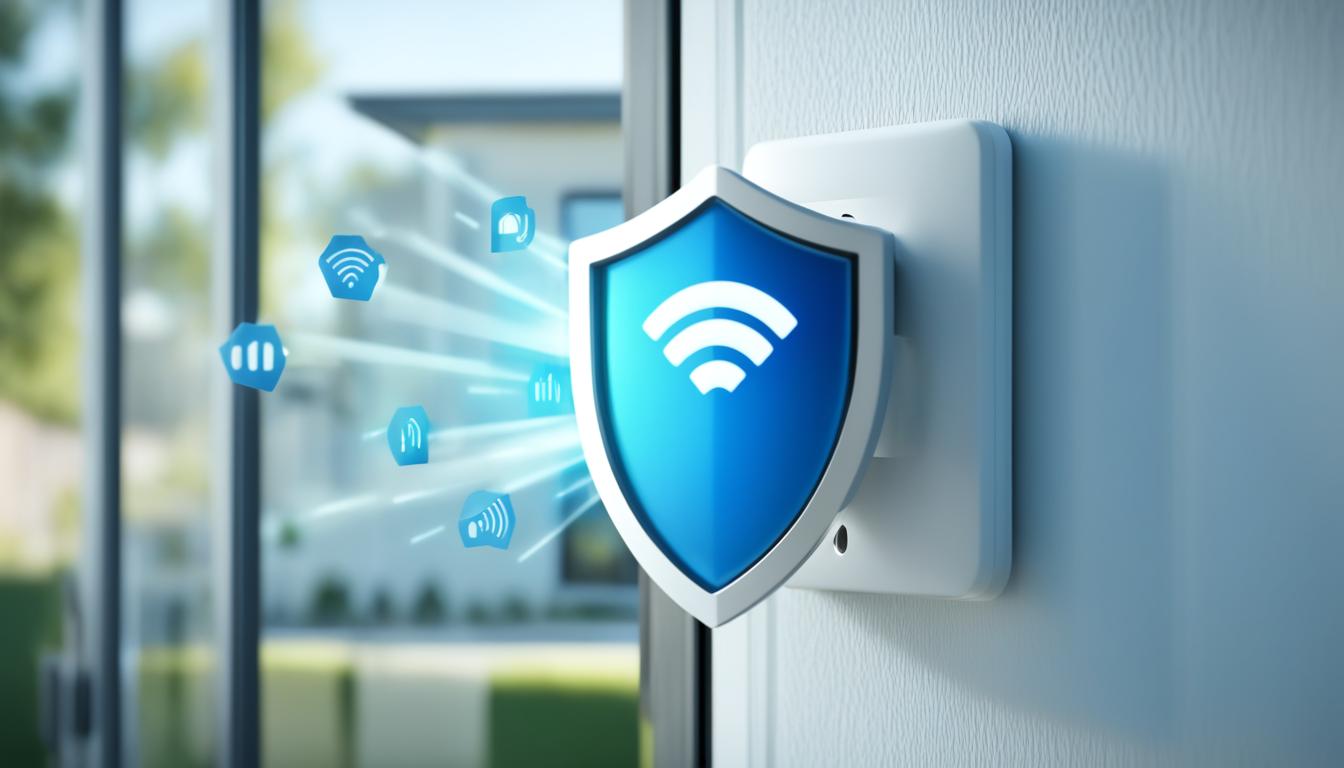With the increasing reliance on technology and the internet, securing your home network is more important than ever. Threats from cybercriminals can put your personal and confidential information at risk. By following these cybersecurity tips, you can enhance the security of your home network and protect your digital life.
Key Takeaways:
- Regularly upgrade and update your devices and software to benefit from the latest security features.
- Secure your routing devices and create a separate wireless network for guests.
- Implement strong Wi-Fi encryption to keep your wireless communications confidential.
- Leverage network segmentation and firewall capabilities to separate and protect your devices.
- Strengthen security with software and user habits, such as using security software and creating strong passwords.
By implementing these cybersecurity measures, you can ensure the safety of your home network and enjoy a worry-free online experience.
Upgrade and Update Your Devices and Software Regularly
Regularly upgrading and updating your devices and software is a critical aspect of maintaining optimal security for your home network. By ensuring that all your devices and software are up to date, you can benefit from the latest security features and patches that protect against common cyber threats.
This includes upgrading and updating routers, computers, laptops, smartphones, and IoT devices. These network security measures ensure that vulnerabilities are addressed and that your devices are equipped with the necessary defenses to combat potential attacks.
To upgrade your devices and software, follow these steps:
- Check for the latest firmware: Visit the manufacturer’s website for each device and verify if updated firmware is available. Firmware updates often include security patches that address vulnerabilities.
- Enable automatic updates: Ensure that the devices and software on your home network are set to automatically download and install updates. This eliminates the need for manual updates and helps to streamline the process.
- Update operating systems: Keep your operating systems, such as Windows, macOS, iOS, and Android, up to date. These updates often include security enhancements that protect against emerging threats.
- Keep applications up to date: Regularly check for updates for all installed applications, including web browsers, antivirus software, and productivity tools. These updates often contain patches that address security vulnerabilities.
By following these network security measures to upgrade and update your devices and software regularly, you can fortify your home network against potential security breaches. Additionally, practicing secure habits such as backing up your data and disconnecting devices when not needed further minimizes the risk of compromise.
Remember, an outdated device or software can be a weak link in your network’s security. Stay one step ahead of cyber threats by prioritizing regular upgrades and updates to protect your digital assets.
Secure Your Routing Devices
Your routing devices serve as the gateway into your home network, making their security a top priority. By implementing the following measures, you can enhance the protection of your Wi-Fi network, ensure routing device security, and maintain network separation.
- Upgrade to a Modern Operating System: Keep your routing devices’ operating systems up-to-date with the latest versions. These updates often include advanced security features that can defend against evolving cyber threats.
- Use a Personally Owned Routing Device: Maximize control over your home network by using a personally owned routing device that connects to your ISP-provided modem/router. This allows you to leverage comprehensive security functionalities and implement customized settings.
- Create a Separate Wireless Network for Guests: Enhance network security by creating a separate wireless network specifically for guests. This helps to ensure network separation from your trusted and private devices, safeguarding your personal data.
Secure Wi-Fi network, routing device security, and network separation are crucial elements in safeguarding your home network from potential threats.

Example Table: Comparison of Router Security Features
| Router Model | Firewall Capabilities | Network Segmentation | Latest Operating System |
|---|---|---|---|
| Brand A | ✅ | ✅ | ✅ |
| Brand B | ✅ | ❌ | ❌ |
| Brand C | ✅ | ✅ | ✅ |
This table compares the router security features of different brands. Choosing a router with advanced firewall capabilities, network segmentation functionality, and regular operating system updates can significantly enhance the security of your routing device.
Implement Strong Wi-Fi Encryption
To ensure the security of your wireless network and protect your sensitive information, it is crucial to implement robust Wi-Fi encryption. By utilizing Wi-Fi Protected Access 3 (WPA3) or WPA2 encryption protocols, you can establish a secure wireless network.
WPA3 and WPA2 encryption methods offer stronger security compared to older encryption standards like Wired Equivalent Privacy (WEP). These advanced encryption protocols provide enhanced protection against unauthorized access and data interception.
To further strengthen the security of your Wi-Fi network, consider the following measures:
- Use a strong and unique passphrase:
- Enable protected management frames:
- Change the default SSID:
- Avoid hiding the SSID:
Choose a complex passphrase that combines uppercase and lowercase letters, numbers, and symbols. This will make it significantly harder for potential attackers to crack your Wi-Fi password.
Protected management frames (PMF) is an optional feature in WPA3 and WPA2 that prevents attacks targeting the management frames of Wi-Fi networks. By enabling PMF, you add an extra layer of security to your wireless network.
By replacing the default SSID (Service Set Identifier) with a unique and non-identifiable name, you make it more difficult for attackers to identify your network and launch targeted attacks.
While you may think that hiding the SSID adds an extra layer of security, it actually makes your network more vulnerable. Attackers with the right tools can easily discover hidden network names. It is recommended to keep the SSID broadcasting to improve network management and visibility.

Comparison of Wi-Fi Encryption Standards
| Encryption Standard | Security Level | Compatibility |
|---|---|---|
| WEP | Weak | Compatible with most devices, but not recommended |
| WPA2 | Strong | Compatible with older and newer devices |
| WPA3 | Strongest | Compatible with newer devices; support for older devices may vary |
Implementing strong Wi-Fi encryption is a critical step in securing your wireless network. By choosing WPA3 or WPA2 encryption and following best practices, you can significantly reduce the risk of unauthorized access and protect your confidential data.
Leverage Network Segmentation and Firewall Capabilities
One effective way to enhance the security of your home network is by implementing network segmentation, which involves separating different parts of your network into distinct sections. By doing this, you can create boundaries that restrict the direct communication between less secure devices, such as guest devices or IoT devices, and more secure devices, like your personal devices. This helps prevent potential threats from easily spreading across your entire network.
In addition to network segmentation, it is crucial to ensure that your personally owned routing device has firewall capabilities. Firewalls act as a barrier between your network and the outside world, monitoring and controlling incoming and outgoing network traffic. Basic firewall capabilities, such as network address translation (NAT) and IPv6 firewall functionalities, add an extra layer of protection to your home network.
If your wireless access points do not provide these firewall capabilities, it may be worth considering purchasing a router that supports them. This will help ensure that your network is well-equipped to defend against potential cyber threats.

Network Segmentation and Firewall Capabilities
| Benefits of Network Segmentation | Benefits of Firewall Capabilities |
|---|---|
| – Limits the spread of threats – Enhances network security – Provides control over device communication |
– Acts as a barrier against unauthorized access – Monitors and controls network traffic – Adds an extra layer of protection |
| – Allows for separate networks for guests and IoT devices | – Supports network address translation (NAT) |
| – Primes your network for secure communication | – Provides IPv6 firewall functionalities |
Strengthen Security with Software and User Habits
To maximize the security of your home network, it is crucial to leverage the power of security software and practice secure user habits. By incorporating these measures, you can significantly enhance the protection of your personal and confidential information.
1. Layered Defense with Security Software
Investing in reliable security software is vital to safeguard your network against various cyber threats. Look for software that offers a layered defense approach, encompassing antivirus, anti-phishing, and anti-malware features. These features work together to detect and neutralize potential risks, ensuring comprehensive network protection.
2. Password Protection with a Password Manager
Using strong, unique passwords for each of your accounts is essential for robust network security. However, it can be challenging to remember multiple complex passwords. That’s where a password manager comes in handy. With a password manager, you can create and store strong passwords, removing the hassle of memorization while ensuring password strength.
3. Limit Administrator Privileges
Operating on an administrator account can expose your network to unnecessary risks. Limit the use of the administrator account and create a separate non-privileged user account for your everyday activities. By doing so, you minimize the potential damage that can occur if an attacker gains access to your administrator account.
4. Safeguard against Eavesdropping
Protecting your privacy within your home network involves more than just securing your digital data. Be mindful of devices with microphones and cameras that could be used to invade your privacy. When not in use, mute devices with microphones and consider covering cameras on laptops and monitoring devices. These simple precautions can thwart potential eavesdropping attempts.
5. Practice Secure User Habits
Developing secure user habits is crucial for maintaining a robust home network. It’s recommended to regularly back up your data to prevent permanent loss in case of a cybersecurity incident. Additionally, minimize the use of public charging stations, as they can be potential vectors for malware transmission. Lastly, turn off devices when not in use to minimize the risk of unauthorized access and conserve energy.

Implementing security software solutions and cultivating secure user habits are critical steps in fortifying your home network against cyber threats. By following these practices, you can rest assured knowing that your network and personal information are well-protected.
Conclusion
Protecting your home network from cyber threats is crucial in today’s digital world. By following these steps to enhance network security, you can safeguard your personal and confidential information and enjoy a worry-free online experience.
Firstly, make sure to upgrade and update your devices regularly. This includes routers, computers, smartphones, and other connected devices. By using the latest software versions and operating systems, you benefit from the latest security patches and features that protect against known vulnerabilities.
Securing your routing devices is also essential. Upgrade to a modern operating system, keep it up-to-date, and use a personally owned routing device whenever possible. By creating a separate wireless network for guests, you create an additional layer of protection and prevent unauthorized access to your trusted devices.
Implementing strong Wi-Fi encryption is another key step. Utilize Wi-Fi Protected Access 3 (WPA3) or WPA2 encryption and set a strong passphrase. Changing the default SSID and avoiding hiding it can further enhance your network security.
Leveraging network segmentation and firewall capabilities adds an extra layer of defense. Separate your primary Wi-Fi, guest Wi-Fi, and IoT networks to prevent less secure devices from accessing more sensitive information. Ensure your routing device supports basic firewall functionalities to block unwanted traffic and protect your network.
Finally, strengthen your security with software and user habits. Install security software that includes antivirus, anti-phishing, and anti-malware features. Utilize a password manager to create strong and unique passwords for all your accounts. Be mindful of telework security and practice secure user habits, such as regular data backups and covering devices’ microphones and cameras when not in use.
By following these internet security guidelines and implementing the necessary steps, you can protect your home network from cyber threats and ensure the safety of your personal information. Stay vigilant, stay protected!
FAQ
Why is it important to upgrade and update devices and software regularly?
Regular upgrades and updates ensure that you have the latest security features and patches that protect against cyber threats.
How can I secure my routing devices?
Upgrade to a modern operating system, keep it up-to-date, and use a personally owned routing device to maximize control over your home network.
How can I implement strong Wi-Fi encryption?
Implement Wi-Fi Protected Access 3 (WPA3) or WPA2 encryption, use a strong passphrase, enable protected management frames, and change the default SSID to something unique.
What is network segmentation, and how does it enhance security?
Network segmentation separates different networks within your home network, ensuring that less secure devices cannot directly communicate with more secure devices.
How can I strengthen security with software and user habits?
Leverage security software with antivirus, anti-phishing, and anti-malware features, use a password manager, limit the use of the administrator account, and exercise secure user habits such as regular data backups and device precautions.
What is the importance of internet security guidelines in securing my home network?
Following internet security guidelines ensures that you take the necessary steps to enhance network security and safeguard your personal and confidential information from malicious actors.








